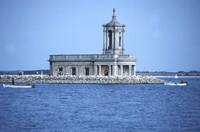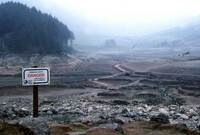There are few opportunities to preserve a complete village.
Buildings and other existing structures are usually demolished before being immersed beneath a new reservoir. It is recorded that the formation of the Elan Valley reservoirs 'occasioned the destruction of two houses of some pretensions and literary interest... both of them houses, the sites of which are situated some forty feet below the top water level of the Caban Coch Reservoir, were associated with the poet Shelley'. Shelley's uncle lived in one of the houses and Shelley lived in the other with his wife, Harriet. A church, a chapel, a school and fourteen cottages were also destroyed (Lees 1908: 6). In a similar manner the village of Mardale was levelled before the Haweswater dam was flooded in 1941. During the drought of 1984 Haweswater fell 21.3m (to its lowest level since 1941) and Mardale was exposed. It soon became a tourist attraction and the Haweswater road had to be closed on busy weekends to prevent congestion. Since diving and underwater archaeology have become popular activities, buildings of this type should now be regarded as accessible. Mardale should have been preserved [Fig 5.16]. There are few opportunities to preserve a complete English village. All of them should be seized.
Similarly, Normanton Church was just inside the margin of the area to be flooded by Rutland Water [Fig 5.17]. It could have been demolished, moved, left alone, or protected by an artificial island. The latter course of action was chosen and the church has become 'the most popular landmark of Rutland Water' (Anglian Water Authority). The filling has however destroyed the classical proportions of the church. In my opinion it would have been better to protect the stonework from erosion and allow the church to appear and disappear as the waters rise and fall. This happened to the Temple of Philae in Egypt before the High Dam was built at Asswan. Philae was 'the most romantic tourist attraction in nineteenth century Egypt' (Baines & Malek 1984: 73).





